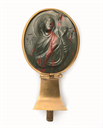Description
The Virgin traditionally held such a privileged place among the saints that she acted as a special advocate, believed to plead with God on behalf of the devout. On this cameo, she turns to the right, stretching out her hands in a gesture of prayer. This stock pose appears on a number of icons, including the stone relief of the Virgin (BZ.1938.62), all of which may be surviving reflections of a lost painted icon, once kept in the Church of the Virgin at Blachernae in Constantinople. That icon had been associated with the soros, a silver reliquary containing the mantle of the Virgin, hence the name, Virgin Hagiosoritissa, or Virgin of the Holy Reliquary. The Hagiosoritissa often faced an icon depicting the object of her intercession, Christ. The version on this pendant integrates Christ in the upper right in the form of a hand emerging from the arc of heaven.
The material, hematite, is an iron oxide that occurs in streaks in igneous, metamorphic, or sedimentary rocks in a variety of colors from dark rust to the most prized hue, bright scarlet, as seen here. The carver seems to have capitalized on the red streak, aligning it with the direction of the Virgin’s prayer. From ancient times, admirers of gems had associated hematite with blood, and had supposed that it had magical medicinal powers including the protection of menstrual functions, and the staunching of uterine bleeding, a symptom of miscarriage. In fact, a Byzantine hematite in the Metropolitan Museum of Art in New York depicts Christ healing the woman with the issue of blood. The Dumbarton Oaks cameo may have served as an amulet for a woman seeking special reproductive protection from the Mother of God.
J. Hanson
Bibliography
Arts of the Middle Ages; a Loan Exhibition, exhibition catalogue, Museum of Fine Arts Boston, February 17 to March 24, 1940 (Boston, 1940), 61, no. 201.
M. C. Ross, Bulletin of the Fogg Art Museum 9.4 (1941), esp. 75.
The Dumbarton Oaks Research Library and Collection of Harvard University, Handbook of the Collection (Washington, D.C., 1946), 73, no. 142, fig. p. 74.
The Dumbarton Oaks Collection, Harvard University (Washington, D.C., 1955), 100, no. 218, fig. p. 102.
S. der Nersessian, "Two Images of the Virgin in the Dumbarton Oaks Collection," Dumbarton Oaks Papers 14 (1960): 69-86, esp. 77-78.
M. C. Ross, Metalwork, Ceramics, Glass, Glyptics, Painting, Catalogue of the Byzantine and Early Mediaeval Antiquities in the Dumbarton Oaks Collection 1 (Washington, D.C., 1962), 101, no. 122, pl. 58.
Handbook of the Byzantine Collection (Washington, D.C., 1967), 99, no. 338.
S. Trümpler, "Die byzantinische Marienkamee der Abegg-Stiftung in Riggisberg," Zeitschrift für schweizerische Archäologie und Kunstgeschichte 43.1 (1986), esp. 13, fig. 6.
A. Kirin, J. N. Carder, and R. S. Nelson, Sacred Art, Secular Context : Objects of Art from the Byzantine Collection of Dumbarton Oaks, Washington, D.C., Accompanied by American Paintings from the Collection of Mildred and Robert Woods Bliss, ed. A. Kirin, exhibition catalogue, Georgia Museum of Art, (Athens, Ga., 2005), 91, no. 6.
G. Bühl, ed., Dumbarton Oaks: The Collections (Washington, D.C., 2008), 162, pl. p. 163.
Exhibition History
Boston, Museum of Fine Arts, "Arts of the Middle Ages," Feb. 17 - Mar. 24, 1940.
Cambridge, MA, Fogg Art Museum, "A Selection of Ivories, Bronzes, Metalwork and Other Objects from the Dumbarton Oaks Collection," Nov. 15 - Dec. 31, 1945.
Athens, GA, Georgia Museum of Art, “Sacred Art, Secular Context: Objects of Art from the Byzantine Collection of Dumbarton Oaks, Washington, D.C., Accompanied by American Paintings from the Collection of Mildred and Robert Woods Bliss,” May 15 – Nov. 6, 2005.
Acquisition History
Purchased from Juritzky-Warberg, Vienna, by Mildred and Robert Woods Bliss, 1936.
Collection of Mildred and Robert Woods Bliss, Washington, DC, 1936-1940.
Dumbarton Oaks Research Library and Collection, Byzantine Collection, Washington, D.C.



